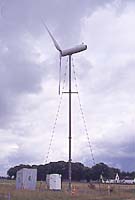Wind
Turbines:
Upwind or Downwind Machines?
![]()
Upwind
Machines
Upwind machines have the rotor facing the wind. The
basic advantage of upwind designs is that one avoids the wind
shade behind the tower. By far the vast majority of wind turbines
have this design.
![]() On the other hand, there is also some wind
shade in front of the tower, i.e. the wind starts bending
away from the tower before it reaches the tower itself, even
if the tower is round and smooth. Therefore, each time the rotor
passes the tower, the power from the wind turbine drops slightly.
On the other hand, there is also some wind
shade in front of the tower, i.e. the wind starts bending
away from the tower before it reaches the tower itself, even
if the tower is round and smooth. Therefore, each time the rotor
passes the tower, the power from the wind turbine drops slightly.
![]() The basic drawback of upwind designs is that
the rotor needs to be made rather inflexible, and placed
at some distance from the tower (as some manufacturers have found
out to their cost). In addition an upwind machine needs a yaw
mechanism to keep the rotor facing the wind.
The basic drawback of upwind designs is that
the rotor needs to be made rather inflexible, and placed
at some distance from the tower (as some manufacturers have found
out to their cost). In addition an upwind machine needs a yaw
mechanism to keep the rotor facing the wind.
Small
downwind turbine (22 kW).
You may notice that the rotor is "coning" away from
the tower.
Photograph
© 1998 Soren Krohn
Downwind
Machines

![]() Downwind
machines have the rotor placed on the lee side of the tower.
They have the theoretical advantage that they may be built without
a yaw mechanism, if the rotor and nacelle have a suitable
design that makes the nacelle follow the wind passively. For
large wind turbines this is a somewhat doubtful advantage, however,
since you do need cables to lead the current away from the generator.
How do you untwist the cables, when the machine has been yawing
passively in the same direction for a long period of time, if
you do not have a yaw mechanism? (Slip rings or mechanical collectors
are not a very good idea if you are working with 1000 ampere
currents).
Downwind
machines have the rotor placed on the lee side of the tower.
They have the theoretical advantage that they may be built without
a yaw mechanism, if the rotor and nacelle have a suitable
design that makes the nacelle follow the wind passively. For
large wind turbines this is a somewhat doubtful advantage, however,
since you do need cables to lead the current away from the generator.
How do you untwist the cables, when the machine has been yawing
passively in the same direction for a long period of time, if
you do not have a yaw mechanism? (Slip rings or mechanical collectors
are not a very good idea if you are working with 1000 ampere
currents).
![]() A more important advantage is that the rotor
may be made more flexible. This is an advantage both in
regard to weight, and the structural dynamics of the machine,
i.e. the blades will bend at high wind speeds, thus taking part
of the load off the tower. The basic advantage of the downwind
machine is thus, that it may be built somewhat lighter than an
upwind machine.
A more important advantage is that the rotor
may be made more flexible. This is an advantage both in
regard to weight, and the structural dynamics of the machine,
i.e. the blades will bend at high wind speeds, thus taking part
of the load off the tower. The basic advantage of the downwind
machine is thus, that it may be built somewhat lighter than an
upwind machine.
![]() The basic drawback is the fluctuation in
the wind power due to the rotor passing through the wind shade
of the tower. This may give more fatigue loads on the
turbine than with an upwind design.
The basic drawback is the fluctuation in
the wind power due to the rotor passing through the wind shade
of the tower. This may give more fatigue loads on the
turbine than with an upwind design.
© Copyright 1998 Soren Krohn. All rights reserved.
Updated 19 January 2001
http://www.windpower.org/tour/design/updown.htm